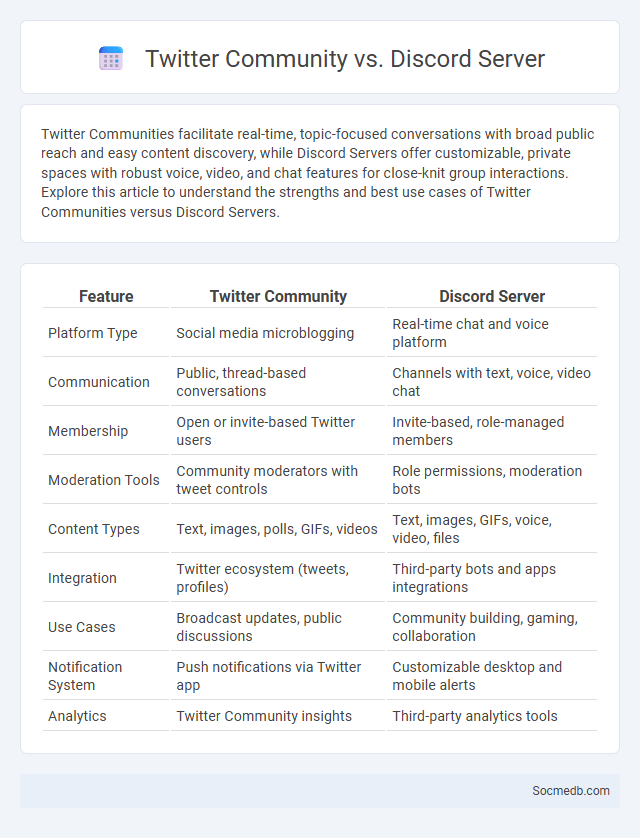
Photo illustration: Twitter Community vs Discord Server
Twitter Communities facilitate real-time, topic-focused conversations with broad public reach and easy content discovery, while Discord Servers offer customizable, private spaces with robust voice, video, and chat features for close-knit group interactions. Explore this article to understand the strengths and best use cases of Twitter Communities versus Discord Servers.
Table of Comparison
| Feature | Twitter Community | Discord Server |
|---|---|---|
| Platform Type | Social media microblogging | Real-time chat and voice platform |
| Communication | Public, thread-based conversations | Channels with text, voice, video chat |
| Membership | Open or invite-based Twitter users | Invite-based, role-managed members |
| Moderation Tools | Community moderators with tweet controls | Role permissions, moderation bots |
| Content Types | Text, images, polls, GIFs, videos | Text, images, GIFs, voice, video, files |
| Integration | Twitter ecosystem (tweets, profiles) | Third-party bots and apps integrations |
| Use Cases | Broadcast updates, public discussions | Community building, gaming, collaboration |
| Notification System | Push notifications via Twitter app | Customizable desktop and mobile alerts |
| Analytics | Twitter Community insights | Third-party analytics tools |
Overview of Online Communities
Online communities consist of virtual spaces where individuals with shared interests interact, collaborate, and exchange information through social media platforms like Facebook, Reddit, and Discord. These communities foster engagement by offering user-generated content, real-time communication, and support networks tailored to various niches such as gaming, hobbies, or professional development. When you actively participate in these online groups, you can expand your network, gain valuable insights, and enhance your digital presence.
What is a Twitter Community?
A Twitter Community is a dedicated space on Twitter where users with shared interests can engage in focused conversations and connect more deeply. Your participation in a Twitter Community allows you to join discussions, share resources, and build relationships with like-minded individuals. These communities enhance the social media experience by fostering meaningful interactions beyond typical public tweets.
Key Features of Discord Servers
Discord servers offer customizable channels that support text, voice, and video communication, fostering real-time interaction among users. Integrated moderation tools and role-based permissions enhance community management and security. Rich media support, including file sharing and bot integrations, boosts engagement and automates tasks within the server.
Defining the General Online Community
The general online community consists of diverse individuals connected through social media platforms, where users share content, engage in conversations, and form digital relationships. This virtual environment fosters collaboration, information exchange, and collective identity across various interests and demographics. Understanding your role within this network enhances interaction quality and strengthens social connectivity in the digital age.
User Engagement: Twitter vs Discord vs General Communities
User engagement on Twitter thrives through real-time interactions, trending hashtags, and retweets, facilitating rapid information dissemination and viral content spread. Discord offers highly interactive, community-driven engagement with voice channels, direct messaging, and topic-specific servers fostering deep, continuous conversations among users. General online communities, including forums and social networks, balance broad accessibility with varying interaction depth, often relying on threaded discussions, polls, and user-generated content to maintain active participation.
Moderation and Safety Tools Comparison
Social media platforms employ diverse moderation and safety tools to address content regulation, user protection, and community standards enforcement. Automated systems, such as AI-driven content filtering and keyword detection, complement human moderators who review flagged content to reduce misinformation, hate speech, and harassment. Comparison of tools highlights differences in transparency, response time, user appeal mechanisms, and the integration of third-party safety features like content warnings and parental controls.
Communication Styles and Interaction Dynamics
Social media platforms shape communication styles by favoring concise, visually-driven content that encourages rapid sharing and immediate feedback. Interaction dynamics on these platforms are characterized by real-time engagement, including likes, comments, and shares, which foster community-building and amplify user voices. Algorithms further influence these dynamics by personalizing content feeds, increasing user interaction and retention through tailored social experiences.
Growth Potential and Member Retention
Social media platforms offer substantial growth potential by leveraging targeted content strategies and data analytics to attract and engage specific audiences. Your ability to consistently provide valuable, interactive content fosters member retention by building trust and encouraging ongoing participation. Optimizing user experience through personalized interactions and community-building features can significantly increase long-term engagement and loyalty.
Use Case Scenarios for Each Platform
Facebook excels in community building and event promotion, making it ideal for businesses targeting diverse age groups and local markets. Instagram's visual-centric platform suits brands focusing on lifestyle, fashion, and influencer marketing to engage younger audiences. LinkedIn provides a professional network for B2B marketing, talent acquisition, and thought leadership, enhancing your industry credibility and connections.
Choosing the Right Platform for Your Community Needs
Selecting the ideal social media platform depends on your community's demographics, interests, and engagement behaviors. Platforms like Facebook offer extensive group features for diverse age groups, while Instagram and TikTok excel in visual content for younger audiences. Analyzing user metrics and content formats helps tailor your choice to maximize interaction and community growth.
 socmedb.com
socmedb.com